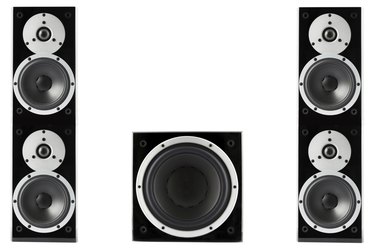
Subwoofers not only add depth and drama to your audio system, they also reduce the demands on your main speakers, allowing smaller speakers to fill big rooms. Subwoofers can be standalone components or part of a home theater system, so the unit you select may dictate how you connect the sub to your system. Older stereo systems may not have dedicated subwoofer support, but contemporary subs can still be used.
Using Dedicated Outputs
Video of the Day
Step 1
Locate the subwoofer preamplifier output. Many surround-sound home theaters and stereo receivers have an output designed for use with a powered subwoofer -- usually one or two RCA-style jacks labeled "Sub," "Pre-Out," "Subwoofer," "SW Out," "LFE" or some combination of these.
Video of the Day
Step 2
Connect a coaxial cable with RCA-style plugs to the subwoofer output on your receiver. These cables are often supplied with the subwoofer. Route this cable to the low-frequency effect jack on the powered subwoofer. This jack is labeled "Line In," "Low Level In," "LFE In" or something similar. There may be other jacks on the subwoofer, but those are unnecessary for this connection type.
Step 3
Connect the subwoofer's power cable to a wall outlet and switch the unit on. Powered subwoofers contain an amplifier dedicated to driving the subwoofer speaker. The subwoofer preamp output provides a low-level signal for the sub's amplifier, and it is not powerful enough to drive speakers on its own.
Receivers With No Subwoofer Output
Step 1
Locate the subwoofer's regular audio inputs to use with receivers that have no dedicated subwoofer support. The subwoofer accepts the signal from your receiver's speaker output in this configuration.
Step 2
Connect the left and right audio inputs on the subwoofer to the left and right speaker outputs on the receiver. The subwoofer usually has RCA-style connectors for this configuration, while your receiver may use bare wire or binding post connections. Add the subwoofer left and right connections to the existing speaker connections, leaving your regular speakers connected as well.
Step 3
Connect the subwoofer's power cable and switch the unit on. Since the sub is receiving the same audio content as your regular speakers, use the subwoofer's crossover control to customize low-frequency response. If your sub has only a volume control, the crossover is internal and low-frequency content is controlled by subwoofer volume only.